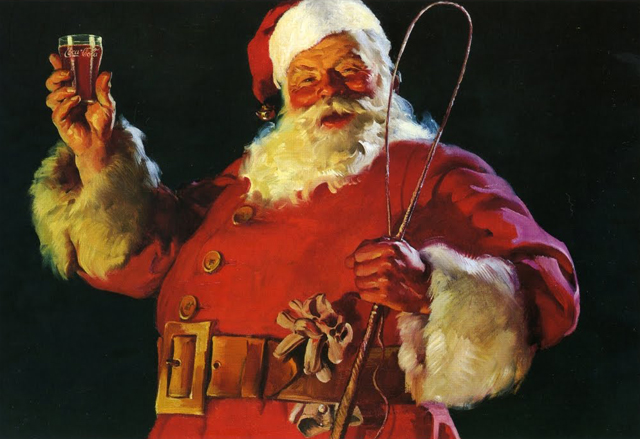
When I started this series 5 years ago, I spotlighted a popular character associated with Christmas time; the curmudgeonly Ebeneezer Scrooge. But, he’s of course not the only seasonal icon that has enjoyed a long time presence on the silver screen. You don’t have to look any further than the symbol of the Holiday himself, Santa Claus, for a wide array of cinematic interpretations. The interesting thing about the cinematic evolution of Santa Claus is that they have both shaped and reshaped his image across every iteration. There really is no clear set of rules for portraying the story of Santa Claus; he pretty much is whatever your story needs him to be. There are of course some universal standards that the portrayal adheres to. He’s got to be rotund, wears a red suit, live up at the north pole, and drives a sleigh propelled by eight flying reindeer. A lot of these rules, however, were established through some of the most noteworthy literary and cinematic interpretations over time, and most of the Santa myth cannot be derived from just one source. That’s been the case throughout history. The real life Saint Nicholas really bears little resemblance to the character that now carries his name today, and the image of Santa borrows mainly from Western European legends. It wasn’t until Clement Clarke Moore’s poem “Twas the Night Before Christmas” that we received a definitive description of this character named Santa Claus, and this has been what has stuck in most people’s minds ever since. The Coca-Cola corporation further reinforced the image of “Jolly Old St. Nick” in their advertising, and that has largely been the image that Hollywood has drawn from as well. But, even with that, it is interesting how the character changes from genre to genre, and also through different actors’ performances. What follows are some of those unique cinematic versions of Santa that I think really represents the broad spectrum that has surprising followed Santa through his history on film.

EDMUND GWENN from MIRACLE ON 34TH STREET (1947)
Though Miracle on 34th Street may not have introduced the character of Santa Claus onto the big screen, it certainly did leave a significant mark on the character. If Coca-Cola managed to popularize the definitive image of Santa in pop culture, 34th Street cemented it forever into the minds of generations to come. Here he is portrayed by Edmund Gwenn, who looks every much the part. Apart from capturing the look of Santa Claus, he also brings out a great amount of charm in his performance; maintaining a sense of purity that every child would want to see in their ideal Santa Claus. There’s an especially sweet moment when he’s confronted by a cynical young girl (played by a very young Natalie Wood), who believes he’s wearing a fake beard. He offers to let her pull it to prove it’s real, and when she does, he feigns a sneeze to playfully remove her doubt. But, the other interesting thing about Mr. Gwenn’s performance is that it is also grounded as well. There is a question left up in the air by the movie whether or not he really is Santa Claus, and the movie does leave the answer open to interpretation. Gwenn does just enough to make you question it, but never dismiss one side or another either, and that makes his role as the enigmatic Kris Kringle all the more effective and layered. It’s so effective that to this day, Edmund Gwenn is the only actor who has won an Academy Award for portraying Santa Claus. There have been two attempts at remaking this classic film, and I feel that both fall short of capturing the mystery of the original, mainly because they fall too heavily for a more whimsical side (although Richard Attenborough’s Kringle in the 1994 remake is still charming). For the character of Santa in pop culture in general, you can see a lot of groundwork laid here through Edmund Gwenn’s endearing version.

JOHN CALL from SANTA CLAUS CONQUERS THE MARTIANS (1964)
Quite a dramatic departure from the usual adventures of Santa Claus. This B-Movie cult classic has Santa abducted by Martians who take him back to their home planet where he can make presents for the Martian children. Yes, this is a real plot to a real movie. And it’s just as ridiculous as you would expect. A favorite of the Mystery Science Theater crowd, this movie has just the right amount of campy charm and the Santa Claus at it’s center is portrayed with the same amount of oddball camp. Character actor John Call’s Santa is still a jolly old soul, but with a slight bit of surliness to his portrayal. Some of the movie’s attempts at humor involve Santa clumsily forgetting the names of his reindeer and telling bad jokes that only illicit a laugh from the audience because of the absence of laughter from the other characters. Even still, his passion for the season is infectious, and it’s easy to see how taken the Martians are by his charm. The movie more or less tries to see how well a character like Santa Claus could fit into the Sci-Fi genre that was all the craze at the time, and though the result is a bit of a trainwreck, it nevertheless has withstood the test of time. Call’s performance as Santa Claus is just quirky enough to make the whole weird experiment work, and the movie is worth checking out just for the surreal aspect of it all. Santa doesn’t quite conquer anything so much as fits in well with any company he finds, and surprisingly that even includes visitors from outer space. It certainly shows that there is a lot of versatility in when and where you could plant a character like Santa into a story, and still have it work as a subversive take on a holiday icon. Hooray for Santy Claus.
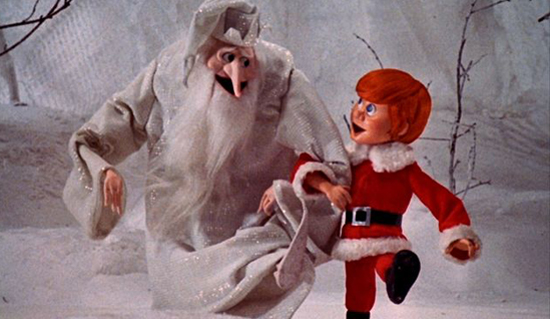
MICKEY ROONEY from RANKIN/BASS’ SANTA CLAUS IS COMIN’ TO TOWN (1970)
If there is a name in Hollywood that is synonymous with the holiday season, it would be the team of Rankin & Bass. The animation duo of Arthur Rankin and Jules Bass were responsible for many of the most beloved Christmas specials that aired on television through the 1960’s and 70’s; most of them in stop-motion animation. Their most famous production, Rudolph the Red-Nosed Reindeer (1964) did feature a Santa in it (a skinny one), but he filled a more supporting role. Santa would play much larger parts in future Rankin/Bass specials, including two where he was given voice by legendary character actor Mickey Rooney. There was 1974’s The Year Without a Santa Claus, where Santa decides to take a break from his yearly duties in order to nurse himself out of a sickness. And then there’s Santa Claus is Comin’ to Town, which tells an imagined backstory for the Christmas icon. The interesting thing about this version is that for most of the film, we are presented with a much younger, beardless Santa Claus. Seeing a sprite, youthful Kris Kringle is something of a departure from other versions of the character we’ve seen, and the voice of Mickey Rooney really captures that jovial energy that a pre-Claus Santa would have. Even still, he does transition into the older Santa that we all know very fluidly by the end, and Rooney is equally up to the task of capturing that part of the character too. Though it’s all fanciful and a bit corny, it is neat to see a movie imagine exactly how this kind of Santa came to be, separated from all the true historical context. We see the reason for giving out toys, the reason he’s named Kringle, and why he wears the red coat. Like most of Rankin/Bass’ work, Santa Claus is Comin’ to Town has a rich nostalgia feeling for most people, and it’s still on most people’s holiday must watch lists.
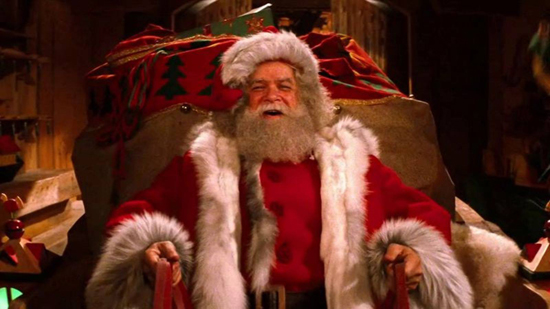
DAVID HUDDLESTON from SANTA CLAUS: THE MOVIE (1987)
Much like Santa Claus is Comin’ to Town, this 1987 flick tries to invent an origin story of it’s own for Santa Claus. Only, this time, the origin has more in common with someone like Superman rather than Rudolph. Santa Claus: The Movie is a strange but interesting film that treats Santa Claus almost like a super hero. We find out his mortal beginnings as a simple toymaker who is taken in by a kingdom of elves who grant him special powers like immortality and super speed in order to spread their toys across the world on Christmas Eve. The Santa in question is not too much different from past Santas, but the way the movie lays out his becoming Mr. Claus almost feels like it owes a bit of inspiration to the likes of Richard Donner’s Superman (1978). He even has a Lex Luthor-esque antagonist he must deal with in the form of John Lithgow’s corporate weasel out to best Santa at his own game. The movie has some strange turns, but it’s lifted by a grounded performance by David Huddleston. In between portraying one of the bigoted residents of Rock Ridge in Blazing Saddles (1974) and the wheelchair-bound curmudgeon barking orders at the Dude in The Big Lebowski (1998), Huddleston left his own distinctive mark on the character of Santa here, and quite frankly, this is one of the very best. The girthy actor with the booming voice just feels like he was born to play the part, so it’s only fitting that he’s given the chance to portray the character at his most epic. Like most fantasies from the 1980’s, this was a movie that relished in going over the top, and thankfully it had it’s own Santa that could easily be larger than life to match it. Make no mistake about it; when you call you film Santa Claus:The Movie, you are making your case for cinematic grandeur, and while some of the movie falls short of this, the portrayal of Santa does not.
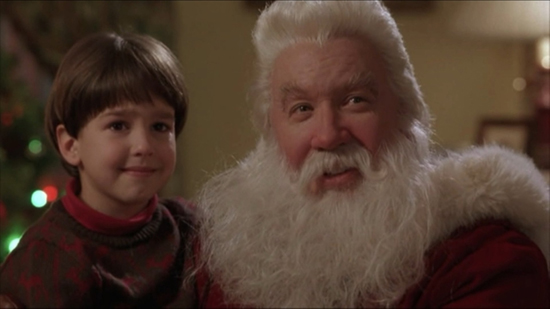
TIM ALLEN from THE SANTA CLAUSE (1994)
Perhaps even more imaginative than a origin story for Santa is the idea that the role of Santa has been passed down through generations, and not always by choice. Even weirder, is seeing someone like Tim Allen filling that role. But, to Tim’s credit, he does a capable enough job of filling Santa’s boots, which is coincidentally the basis for this movie’s unique, and kind of disturbing premise. After causing the accidental death of Santa Claus, Allen’s character puts on the red suit and finishes the job so that Christmas won’t be ruined on account of his mistake. Unfortunately for him, by putting on the suit, he inadvertently signed on to become Santa’s replacement, a contract (the titular Santa Clause) that he’s now cosmically linked to, and pretty soon he’s gaining the weight and growing the beard. The fact that the role of Santa must be carried over, even without the full consent of the person in question, is a little on the extreme side, but the movie benefits a great deal from Tim Allen’s comedic presence here. Allen smartly avoids going heavily into Santa Claus shtick and plays the role pretty close to his own comedian persona; which is exactly what the movie calls for. This is about the average man transforming into Santa Claus, so it makes sense that even as he physically changes into Santa, he’s still the same man underneath. Even the snarky grouchiness remains, although tempered enough to match the sweetness of the movie. Thanks to that, the movie remains funny and charming, and it still remains Tim Allen’s most memorable screen role (minus his voice work as Buzz Lightyear). Just don’t think too much about the unforgiving implications that constitutes the initial “Santa Clause” premise.

ED ASNER from ELF (2003)
Here we come to one of my favorite Santas from one of my favorite Christmas movies. Though he doesn’t feature very prominently in the overall plot, Ed Asner’s Santa is a wonderfully realized version of the character. I love the fact that he is knowledgeable enough to give Will Farrell’s Buddy the Elf advice about New York City, like avoiding Peep Shows and knowing that the real “original”Ray’s Pizza is on 11th. But, Asner also brings a warm sense of unconditional love to the character as well. He recognizes the clumsiness of Buddy within the workshop and the fact that he just doesn’t fit in, but he doesn’t answer this with scorn but with encouragement. He helps Buddy find his real place, while still treating him like one of the family; essentially making this Santa feel much more like a very open-hearted grandfather. Ed Asner, who’s made a career out of playing lovable curmudgeons, from Lou Grant to Up’s Carl Fredrickson, brings out a lot of charm in his performance, and the fact that he’s playing the role contrary to all the other character types he’s played fits very well with the movie’s tone. Elf is a movie that in some ways parodies a lot of Christmas classics, while at the same time attempts to be one itself; poking fun while also embracing it’s identity. You can easily understand why Buddy shouts like a mad man when hearing Santa’s name, in one of the movie’s most hilarious moments. Asner channels his curmudgeon personality, but fills it with the pure heart of Santa Claus and it works incredibly well. In many ways, he’s one of the most well rounded and endearing versions of Santa, and unless you are a member of the Central Park Rangers, you can always find a friend in this Santa Claus.
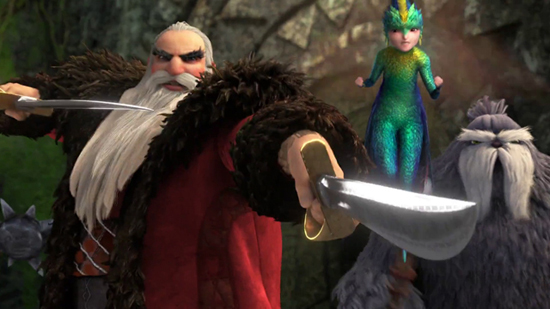
ALEC BALDWIN from RISE OF THE GUARDIANS (2012)
Dreamworks Animation tried their best to create an Avengers style super team of holiday icons, but the effort mostly fell flat and has not been revisited since. This is mainly due to a film that lacked cohesion and characters that were never fleshed out fully; the clearest example of trying too hard being the somewhat “sexy” makeover of Jack Frost. But, if there was anything that the movie got right, it was the portrayal of Santa Claus. Named North in the movie, Santa is transformed into a double sword wielding, Russian accented warrior, and he is incredibly enjoyable. He stands out mainly because he’s the character with the most personality in the entire film, and actor Alec Baldwin thankfully is hamming it up with his performance. The design of the character is also appealing, still maintaining a traditional look for Santa with the white beard and red coat, but re-imagined with a Russian Kosack influence and warrior tattoos all over his arms. In many ways, I wish the movie had dispensed with all of the other holiday characters and just focused on Santa instead, because he’s deserving of his own story on the big screen. It’s clear that the animators had the most fun with Santa as well, giving North the wildest expressions and the most erratic of movements throughout the film, no doubt trying to match the energy of Baldwin’s vocal performance. In many ways, after seeing so many traditional takes on the character of Santa, it’s refreshing to see one that is entirely different, and I just wish that more of the movie was devoted towards exploring that further, instead of focusing on boring Jack Frost. Still, the attempt is worthwhile and the movie is worth seeing for the most bad ass version of Santa Claus we’ve seen yet. Santa Claus: The Movie drew inspiration from super hero myths to give Santa an intriguing origin. Rise of the Guardians just makes him a super hero, and that’s kinda cool in the end.
So, you can see that Santa’s history on the big screen has been a wildly diverse one. Amazingly he can be planted into any genre, and still maintain his identity throughout. He’s conquered martians, fought demons, survived wars, fixed marriages, went on killing sprees, been sued, was kidnapped by the Pumpkin King, and was even saved by Ernest. While some movies try to twist the image of Santa a little bit, there are several things that remain the same throughout every iteration. Santa remains the symbol of the holiday season, a kind soul whose only mission is to spread gifts and cheer to all the people of the world. That’s why he is often presented as this ideal of charity in so many films. While many movies present the incredible feat of spreading gifts to children across the world, what really makes Santa stand out is his heart. What movies like Santa Claus: The Movie and Miracle on 34th Street in particular capture is the essence of why Santa does what he does every year; because someone has to. He doesn’t just bring gifts to everyone; he’s a living reminder of why we give gifts in the first place, as a way of showing someone else that they are loved. The greatest gift given out during the holidays is from someone who you don’t even know, especially when you are in your lowest place at that moment. Santa encourages all of us to be a Santa to someone else, and spread charity throughout the world, especially to those who need it most. That is why he’s an especially valuable character in movies today, because he sets the example for all of us to live by during the holiday season. Sure, he may be a mythical creation that’s been commercially exploited for decades, but the essence of Santa Claus is still something that is worth presenting generation after generation. That’s why it’s worthwhile to have our children believe in a Santa Claus, because it might encourage them to want to continue his example in their own life. So as we hear him exclaim as he drives through the night, “Merry Christmas to all, and to all a good night.”